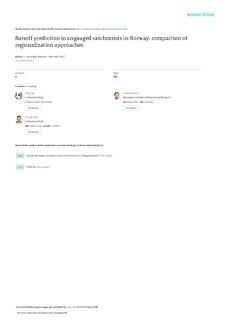Runoff prediction in ungauged catchments in Norway: comparison of regionalization approaches
Journal article, Peer reviewed
Accepted version

Permanent lenke
http://hdl.handle.net/11250/2590192Utgivelsesdato
2018-04-01Metadata
Vis full innførselSamlinger
- Divisjon for skog og utmark [522]
- Publikasjoner fra CRIStin - NIBIO [4576]
- Vitenskapelige artikler [1416]
Sammendrag
Runoff prediction in ungauged catchments has been a challenging topic over recent decades. Much research have been conducted including the intensive studies of the PUB (Prediction in Ungauged Basins) Decade of the International Association for Hydrological Science. Great progress has been made in the field of regionalization study of hydrological models; however, there is no clear conclusion yet about the applicability of various methods in different regions and for different models. This study made a comprehensive assessment of the strengths and limitations of existing regionalization methods in predicting ungauged stream flows in the high latitudes, large climate and geographically diverse, seasonally snow-covered mountainous catchments of Norway. The regionalization methods were evaluated using the water balance model – WASMOD (Water And Snow balance MODeling system) on 118 independent catchments in Norway, and the results show that: (1) distance-based similarity approaches (spatial proximity, physical similarity) performed better than regression-based approaches; (2) one of the combination approaches (combining spatial proximity and physical similarity methods) could slightly improve the simulation; and (3) classifying the catchments into homogeneous groups did not improve the simulations in ungauged catchments in our study region. This study contributes to the theoretical understanding and development of regionalization methods. Runoff prediction in ungauged catchments in Norway: comparison of regionalization approaches